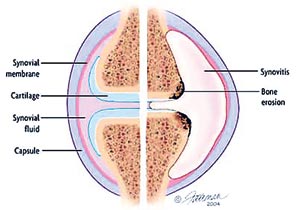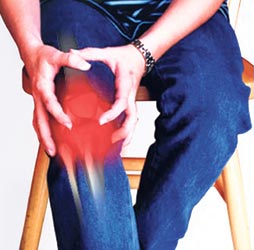Rheumatoid Arthritis (RA) has long been feared as one of the most disabling types of arthritis, but there’s good news for many newly diagnosed patients. RA remains a serious disease, and one that can vary widely in symptoms and outcomes but recent advances in treatment have made it possible to stop or at least slow the progression of joint damage.
RA is the most common form of inflammatory arthritis, affecting millions around the world. Of these, about 75 percent are women. In fact, 1–3% of women may develop rheumatoid arthritis in their lifetime. The disease most often begins between the fourth and sixth decades of life. However, RA can develop at any age.
Some new therapies target inflammation thanks to exciting and rapidly developing research in this area; others involve combinations of existing medications to increase benefit for those who suffer from the disease.
What is rheumatoid arthritis?
RA is a chronic disease that causes pain, stiffness, swelling and limitations in the motion and function of multiple joints. While RA can affect any joint, the small joints in the hands and feet tend be involved more frequently than others. This produces a pattern of joint disease that rheumatologists regard as characteristic of RA. Inflammation can develop in other organs as well.
The stiffness seen in active RA is typically worst in the morning and may last one to two hours or throughout the entire day. This long period of morning stiffness is an important diagnostic clue, since few other arthritic diseases behave this way. For example, osteoarthritis does not generally cause prolonged morning stiffness.
Other symptoms:
- Loss of energy
- Low-grade fevers
- Loss of appetite
- Dry eyes and mouth from an associated condition known as Sjogren’s syndrome
- Firm lumps, called rheumatoid nodules, which grow beneath the skin in areas such as the elbow and hands.
What causes rheumatoid arthritis?
RA is classified as an autoimmune disease, which develops because certain cells of the immune system don’t work properly and begin attacking healthy joints.
While the cause of RA remains unknown, new research is giving us a better understanding of the immune and even genetic factors that may be involved in producing inflammation.
The primary focus of the inflammation is in the synovium, which is the tissue that lines the joint. Inflammatory chemicals released by the immune cells cause swelling and damage to cartilage and bone.
In response, new medications have been developed to specifically block certain signals that cause the body to attack its own immune system resulting in RA symptoms and joint damage.
How is rheumatoid arthritis diagnosed?
RA can be difficult to diagnose because it may begin with only subtle symptoms, such as achy joints or a little stiffness in the morning. Additionally, many diseases, especially early on, behave like RA. The diagnosis of RA is based on the symptoms described and physical examination findings such as warmth, swelling and pain in the joints. Certain blood levels commonly found in RA can help in establishing a diagnosis. Tell-tale signs include:
- Anaemia (a low red blood cell count).
- Rheumatoid factor (an antibody eventually found in approximately 80% of patients with RA, but in as few as 30% at the start of arthritis).
- Antibodies to cyclic citrullinated peptides (CCP).
- Elevated erythrocyte sedimentation rate (a blood test that, in most patients with RA, tends to confirm the amount of inflammation in the joints).
X-rays can be very helpful in diagnosing RA, but may not show any abnormalities in the first 3–6 months of arthritis. These X-rays are, however, useful in determining if the disease is progressing. MRI and ultrasound are also being used more frequently to help detect the severity of RA.
It is important to remember that, for most patients with this disease (especially those who have had symptoms for fewer than six months), there is no single test that “confirms” a diagnosis of RA. Rather, diagnosis is established by evaluating the symptoms and results from a physical exam, laboratory tests and X-rays.
How is rheumatoid
arthritis treated?
Therapy for patients with RA has improved dramatically over the past 25 years. Current treatments offer most patients good to excellent relief of symptoms and the ability to continue to function at or near normal levels. Although there is no cure for RA, the goal of treatment is to minimize patients’ symptoms and disability by introducing appropriate medical therapy as soon as possible, before the joints are permanently damaged. No single therapy is effective for all patients, and many will need to change treatment strategies during the course of their lifetime.
Successful management of RA requires early diagnosis and, at times, aggressive treatment. Patients with an established diagnosis of rheumatoid arthritis should begin treatment with disease-modifying anti-rheumatic drugs (DMARDs). DMARDs are often used in conjunction with NSAIDs and/or low dose corticosteroids. DMARDs have greatly improved the symptoms and function as well as the quality of life for the vast majority of patients with RA. DMARDs include methotrexate, leflunomide, hydroxychloroquine, sulfasalazine, azathiaprine and cyclosporine
 |
| The normal joint structure is pictured on the left. On the right is the joint affected by rheumatoid arthritis which has swelling of the synovium that can lead to damage to cartilage and bone. |
For patients with more significant disease, medications referred to as biologic response modifiers or “biologic agents” can specifically target parts of the immune system that lead to inflammation, joint and tissue damage. These medications are also DMARDs, because they slow the progression of the disease. FDA-approved treatments include adalimumab, anakinra , etanercept , infliximab , abatacept , and rituximab. Typically these are used with methotrexate as the combination is more beneficial.
The optimal treatment of RA often requires more than medication alone. Proper treatment requires comprehensive, coordinated care, patient education and the expertise of a number of providers, including rheumatologists, primary care physicians, and physical and occupational therapists.
Regular visits with the rheumatologist are necessary to follow the course of the disease and monitor for any side effects related to medications. Regular blood tests and occasional X-rays or CT-scans are necessary as well to manage RA and medications effectively.
whose disease is not well controlled, may have a higher risk for heart disease and stroke. Talk with your physician about risks and ways to minimize it.
Living with rheumatoid arthritis
It is important for people with RA to remain physically active, while occasionally scaling back activities when the disease flares. A consultation with a physical or occupational therapist may help to determine types and what levels of activities are appropriate. In general, rest is helpful when a joint is swollen and inflamed, or when feeling fatigued. At these times, gentle range-of-motion exercises will keep the joint flexible. When feeling better, low-impact aerobic exercises such as walking and exercises to boost muscle strength will improve overall health and reduce pressure on joints.
The diagnosis of a chronic illness is a life-changing event that can cause anxiety and occasional feelings of isolation or depression.
Thanks to dramatically improved treatments, these feelings usually decrease with time as energy improves, and pain and limitation decrease. It is important to discuss these normal reactions to illness with health care providers, who can provide the information and resources needed during treatment.
(The writer is a Consultant Rheumatologist)
|



